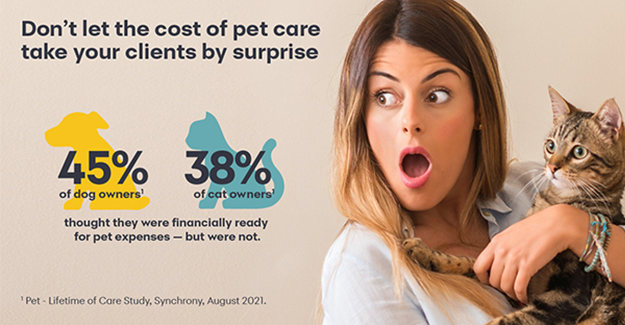Be proactive and purposeful when discussing the cost of pet care

When a prospective pet owner sets eyes on their future fur baby, they’re not likely to be thinking about how much money they’ll spend on that companion over the next 15 years or so. If costs do enter their mind, they’re liable to vastly underestimate them.
That’s according to the Synchrony Lifetime of Care study, which reports that pet owners can spend up to $55,000 on a dog and $45,000 on a cat over the course of the pet’s life. This and other insights from the study can help you prepare clients for the cost of care. Let’s take a look at how.
Prepare new pet owners for costs they may not anticipate.
The Lifetime of Care Study asked pet owners if they thought they were financially prepared for pet ownership at the beginning—and if, after a few years, the reality matched their expectation. Nearly half of dog owners (45%) and over a third of cat owners (38%) thought they were financially ready for pet expenses—but were not.
What does this mean for you? When a client comes in with a new puppy or kitten, help them prepare for a lifetime of quality pet care by helping them understand what those potential costs may be throughout their pet’s life:
|
|
Dog |
Cat |
|
Initial costs, including spay/neuter |
$567 to $1,337 |
$371 to $861 |
|
Average year |
$1,269 to $2,803 |
$960 to $2,487 |
|
Lifetime (15 years) |
$19,893 to $55,132 |
$15,055 to $45,790 |
Recognize that an invoice of $250 or less may cause anxiety.
The study also asked pet owners about their level of stress related to unexpected pet care expenses, along with the amount of the bill that caused that anxiety. One in four respondents said they were stressed out by a bill of $250 or less, which many veterinarians may find surprising.
Regardless of the price point, present a treatment plan with options for care along with associated costs. Whatever you do, make sure they’re not hearing the total for the first time at the checkout desk—even if it’s just a hundred dollars or so.
Be upfront and open about the financial options you provide to help manage cost.
The best time to talk about financial preparedness is before a pet owner is in crisis. Things like pet insurance and flexible financing for pet health expenses can provide peace of mind and help pet owners budget for care. In fact, 53% of pet owners said they would use a credit card dedicated to pet care, even though the vast majority— 86%—did not have one.
If you help these pet parents understand the options available to them before the first potential anxiety-inducing invoice, you just may help them avoid financial stress altogether. The goal is relaxed clients and healthy patients, which means your veterinary team can relax and feel good.
For more information about this study, visit www.petlifetimeofcare.com.
Written by Boo Larsen, Senior Vice President & General Manager, Veterinary Profession, CareCredit



